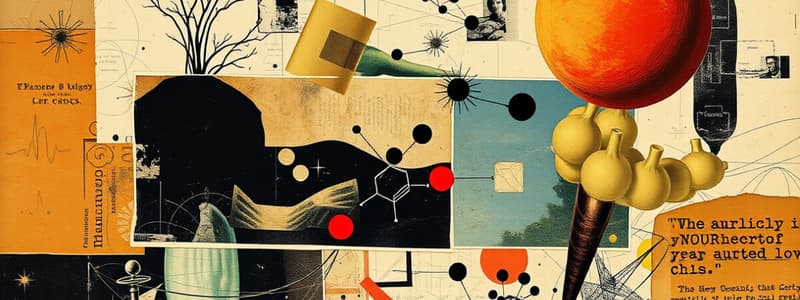Podcast
Questions and Answers
What mechanism allows the living cells to prevent over-accumulation of metabolic products?
What mechanism allows the living cells to prevent over-accumulation of metabolic products?
- Competitive inhibition
- Feedback inhibition (correct)
- Covalent bonding
- Allosteric modulation
Which axiom relates to the regulation of metabolic reactions and enzyme synthesis for efficiency?
Which axiom relates to the regulation of metabolic reactions and enzyme synthesis for efficiency?
- 9th Axiom (correct)
- 10th Axiom
- 7th Axiom
- 8th Axiom
Which feature of genetic information stored in DNA contributes to its extraordinary stability?
Which feature of genetic information stored in DNA contributes to its extraordinary stability?
- Structural complementarity (correct)
- Chromosomal organization
- Transcriptional regulation
- DNA redundancy
What does the 10th Axiom state regarding genetic information?
What does the 10th Axiom state regarding genetic information?
What are the implications of infrequent errors of mutation in DNA?
What are the implications of infrequent errors of mutation in DNA?
Which of the following is NOT a characteristic of DNA break repair?
Which of the following is NOT a characteristic of DNA break repair?
What allows living organisms to build and maintain intricate structures from simple raw materials?
What allows living organisms to build and maintain intricate structures from simple raw materials?
Which characteristic is NOT associated with living organisms?
Which characteristic is NOT associated with living organisms?
Which statement best describes biomolecules in living organisms?
Which statement best describes biomolecules in living organisms?
What is the primary goal of biochemistry as a science?
What is the primary goal of biochemistry as a science?
Which macromolecule component is most abundant in living cells?
Which macromolecule component is most abundant in living cells?
How many different kinds of proteins are estimated to be present in humans?
How many different kinds of proteins are estimated to be present in humans?
What role do the chemical compounds in living organisms serve?
What role do the chemical compounds in living organisms serve?
Which of the following is true regarding the internal structure of cells in living organisms?
Which of the following is true regarding the internal structure of cells in living organisms?
What distinguishes the role of nucleic acids in living organisms?
What distinguishes the role of nucleic acids in living organisms?
What defines the specificity of molecular interactions in cells?
What defines the specificity of molecular interactions in cells?
Which of the following is a characteristic of heterotrophic cells?
Which of the following is a characteristic of heterotrophic cells?
What is the primary role of ATP in cellular processes?
What is the primary role of ATP in cellular processes?
What occurs to ATP when it transfers energy to other molecules?
What occurs to ATP when it transfers energy to other molecules?
Which statement accurately describes the function of ADP?
Which statement accurately describes the function of ADP?
Which of the following best explains enzyme-substrate interactions?
Which of the following best explains enzyme-substrate interactions?
What do sequences of consecutive enzyme-catalyzed reactions accomplish in cells?
What do sequences of consecutive enzyme-catalyzed reactions accomplish in cells?
The absorption of radiant energy by chlorophyll primarily converts it into what form?
The absorption of radiant energy by chlorophyll primarily converts it into what form?
Which of the following statements about the relationship between chemical reactions and energy transfer is true?
Which of the following statements about the relationship between chemical reactions and energy transfer is true?
What does the first axiom about cell macromolecules imply?
What does the first axiom about cell macromolecules imply?
Which axiom supports the idea that all living organisms share a common ancestor?
Which axiom supports the idea that all living organisms share a common ancestor?
What is the reason for the characteristic sets of nucleic acids and proteins in each species?
What is the reason for the characteristic sets of nucleic acids and proteins in each species?
What does the principle of molecular economy suggest about living cells?
What does the principle of molecular economy suggest about living cells?
According to the 1st Law of Thermodynamics, how do living organisms interact with energy?
According to the 1st Law of Thermodynamics, how do living organisms interact with energy?
What does the 2nd Law of Thermodynamics state about physical and chemical processes?
What does the 2nd Law of Thermodynamics state about physical and chemical processes?
How are macromolecules constructed in living organisms?
How are macromolecules constructed in living organisms?
Which statement about energy transformations in living organisms is incorrect?
Which statement about energy transformations in living organisms is incorrect?
What is the implication of building-block biomolecules being identical in all species?
What is the implication of building-block biomolecules being identical in all species?
What defines living organisms as open systems in thermodynamic terms?
What defines living organisms as open systems in thermodynamic terms?
Which statement best describes the steady state condition of a living organism?
Which statement best describes the steady state condition of a living organism?
How are living cells characterized in terms of temperature?
How are living cells characterized in terms of temperature?
What is a key feature of energy utilized by living cells from their environment?
What is a key feature of energy utilized by living cells from their environment?
In thermodynamics, what occurs during the disordering of the environment by living organisms?
In thermodynamics, what occurs during the disordering of the environment by living organisms?
Which statement accurately describes enzyme-catalyzed reactions in living cells?
Which statement accurately describes enzyme-catalyzed reactions in living cells?
What is true about the pressure conditions within a living cell?
What is true about the pressure conditions within a living cell?
What is the implication of the 6th Axiom of living cells relating to their function?
What is the implication of the 6th Axiom of living cells relating to their function?
Which condition differentiates living cells from closed systems?
Which condition differentiates living cells from closed systems?
What is a characteristic of the energy transformation process in living cells?
What is a characteristic of the energy transformation process in living cells?
Flashcards are hidden until you start studying
Study Notes
Introduction to Biochemistry
- Living organisms are composed of molecules following physical and chemical laws of matter.
- Living matter displays unique characteristics that sharply contrast with non-living matter despite both being made of inanimate molecules.
Identifying Characteristics of Living Matter
- Living organisms exhibit complexity and high organization, with cells containing intricate internal structures made of complex molecules.
- Each component of a living organism has a specific function, including macroscopic structures and chemical compounds within cells.
- Organisms can extract and transform energy from their environment to build and maintain structures from simple materials and perform work, such as locomotion.
- Living organisms possess the ability to replicate precisely.
Biochemistry and the Living State
- There is a radical difference between living and non-living matter, primarily in how molecules interact to sustain life.
- The goal of biochemistry is to uncover how inanimate molecular collections in living organisms work together to create and maintain life.
Biomolecules
- Living organisms consist mainly of organic compounds primarily containing carbon, often with nitrogen.
- E. coli serves as a model organism containing approximately 5,000 different compounds, including around 3,000 proteins and 1,000 nucleic acids.
- Macromolecules like proteins and nucleic acids form the bulk of organic material in cells and boast high molecular weights.
- Humans possess over 100,000 distinct proteins, with no protein molecule from E. coli being identical to human proteins.
- Cell macromolecules are constructed from simple building blocks, emphasizing molecular simplicity across cell types.
Axioms of Molecular Organization
- First Axiom: Simplicity exists in cellular molecular organization.
- Second Axiom: All living organisms share a common ancestor due to the identical nature of building-block biomolecules.
- Third Axiom: Each species' identity is maintained by its unique sets of proteins and nucleic acids.
- Fourth Axiom: Living organisms exhibit molecular economy, containing the fewest types of molecules necessary for life and species identity.
Energy Transformations in Living Cells
- According to the 2nd Law of Thermodynamics, all processes increase entropy or disorder in the environment.
- The 1st Law asserts that energy cannot be created or destroyed; living organisms only transform energy from one form to another.
- Living organisms interact with their environment, resulting in increased disorder while maintaining their internal orderliness.
Thermodynamic Principles
- Living organisms are open systems, constantly exchanging energy and matter with their surroundings.
- They function in a steady state, with rates of energy and matter transfer balanced.
- Living cells are isothermal and cannot utilize heat as a work source—energy is instead absorbed and transformed into chemical energy for work at constant temperature.
Chemical Reactions in Living Cells
- Enzymatic reactions yield 100% efficiency without by-products, with each enzyme responsible for a specific reaction.
- Metabolic reactions connect in network pathways, allowing energy transfer through sequences of reactions.
- Seventh Axiom: Specificity in molecular interactions arises from structural complementarity (e.g., enzyme-substrate "lock and key" fit).
Energy Sources in Living Cells
- Photosynthetic cells utilize sunlight as energy while heterotrophic cells derive energy from organic molecules.
- ATP serves as the primary energy carrier in cells, converting into ADP during energy transfer and regeneration when absorbing energy.
Self-Regulation of Cell Reactions
- Metabolism regulation occurs through feedback inhibition, stopping production when an end-product accumulates.
- Cells adjust enzyme synthesis to optimize metabolic efficiencies.
Self-Replication of Living Organisms
- Genetic information is highly stable and serves as the blueprint for cellular organisms, encoded in DNA through nucleotide sequences.
- Structural complementarity allows one DNA strand to dictate the replication of a complementary strand, ensuring accuracy.
- DNA can experience breaks or mutations, which are typically repaired or may provide beneficial evolutionary adaptations.
Additional Notes
- Genetic information, while minute in size, is hugely complex and critical for organismal identity and function.
- Stability and redundancy in genetic coding enhance reliable inheritance and adaptation.
Studying That Suits You
Use AI to generate personalized quizzes and flashcards to suit your learning preferences.




